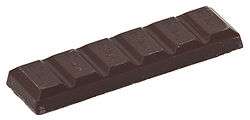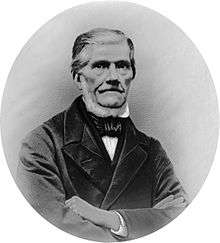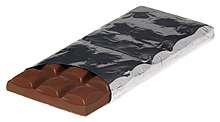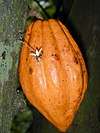Chocolate bar

A chocolate bar is a chocolate confection in an oblong or rectangular form, which distinguishes it from bulk dark chocolate produced for commercial use or individually portioned chocolates such as pastilles,[1] bon-bons, and truffles. In most of the English-speaking world, chocolate bar also refers to a typically snack-sized bar coated with or substantially consisting of chocolate but containing other ingredients. The first solid chocolate bar was produced by Fry's of Bristol, England in 1847, which was then mass-produced as Fry's Chocolate Cream in 1866.[2]
A chocolate bar made exclusively from chocolate contains some or all of the following components: cocoa solids, cocoa butter, sugar, and milk. The relative presence or absence of these define the subclasses of chocolate bar made of dark chocolate, milk chocolate, and white chocolate. In addition to these main ingredients a chocolate bar may contain flavorings such as vanilla and emulsifiers such as soy lecithin to alter its consistency. While vanilla is the most common flavouring, many other flavours are available, including mint, orange, and coffee.
Chocolate bars containing other ingredients feature a wide variety of layerings or mixtures that include nuts, fruit, caramel, nougat, and fondant. A popular example is a Snickers bar, which consists of a nougat mixed with caramel and peanuts. Chocolate bars are often loosely called candy bars in American English, a term that encompasses similar treats produced without chocolate, such as the Zagnut and Bit-o-Honey bars. A wide selection of similar chocolate treats are produced with added sources of protein and vitamins. These include energy bars, protein bars and granola bars sold as snacks or nutritional supplements.
History

Up to and including the 19th century, confectionery of all sorts was typically sold in small pieces to be bagged and bought by weight. The introduction of chocolate as something that could be eaten as is, rather than used to make beverages or desserts, resulted in the earliest bar forms, or tablets. At some point, chocolates came to mean any chocolate-covered sweets, whether nuts, creams (fondant), caramel candies, or others. The chocolate bar evolved from all of these in the late-19th century as a way of packaging and selling candy more conveniently for both buyer and seller; however, the buyer had to pay for the packaging. It was considerably cheaper to buy candy loose, or in bulk.
The production of chocolate specifically meant to be eaten in bars may predate the French Revolution. The Marquis de Sade wrote to his wife in a letter dated May 16, 1779, complaining about the quality of a care package he had received while in prison. Among the requests that he made for future deliveries were for cookies that "must smell of chocolate, as if one were biting into a chocolate bar." This phrasing is highly suggestive of chocolate bars being eaten by themselves and not just grated into chocolate-based drinks, as was a far more common use at this time. Such a product would predate the invention of the cocoa press by Coenraad Johannes van Houten and other innovations which made chocolate suitable for mass-production.[3]
In 1847, Joseph Fry discovered a way to mix the ingredients of cocoa powder, sugar and cocoa to manufacture a paste that could then be molded into a chocolate bar proper for consumption.[2][4] Subsequently, his chocolate factory, Fry's of Bristol, England, began mass-producing chocolate bars and they became very popular.[5] The firm began producing the Fry's Chocolate Cream bar in 1866.[4] Inspired by Fry, John Cadbury, founder of Cadbury, introduced his brand of the chocolate bar in 1849. That same year, Fry and Cadbury chocolate bars were displayed publicly at a trade fair in Bingley Hall, Birmingham.[6] Over 220 Fry's products were introduced in the following decades, including production of the first chocolate Easter egg in the UK in 1873 and Fry's Turkish Delight (or Fry's Turkish bar) in 1914.[4]

Although chocolate bars had their beginnings in the mid 19th century, their sales grew most rapidly in the early-20th century.[7] Milk chocolate was invented in Switzerland by Daniel Peter and Henri Nestlé in 1875.[8] In 1897, following the lead of Swiss companies, Cadbury introduced its own line of milk chocolate bars, with Cadbury Dairy Milk, produced in 1905, becoming the company's best selling bar.[9] In North America, Ganong Bros., Ltd. of St. Stephen, New Brunswick, Canada developed and began selling their version of the modern chocolate bar in 1910. The Hershey Chocolate Company took the lead in the U.S.[7]
The world's largest "chocolate bar" was produced as a stunt by Thorntons plc (UK) on 7 October 2011. It weighed 5,792.50 kg (12,770.3 lb) and measured 4m by 4m by 0.35m.[10] Some of the oldest preserved chocolate bars are two pieces of white and dark chocolate made between 1764 and 1795 for the king of Poland, Stanislaus Augustus Poniatowski, as a gift for his courtiers.[11] Each bar, possibly made by the royal confectioner in Warsaw, bears the King's monogram, SAR, and is on display in his summer residence, Palace on the Water, in Warsaw.[11]
See also
References
- ↑ Dark Chocolate Pastilles. Haigh's Chocolates.
- 1 2 3 Mintz, Sidney (2015). The Oxford Companion to Sugar and Sweets. Oxford University Press. p. 157.
- ↑ Grivetti, Louis; Shapiro, Howard-Yana (2009). Chocolate: History, Culture and Heritage. Hoboken, New Jersey: John Wiley & Sons. p. 746. ISBN 978-0-470-12165-8.
- 1 2 3 "The History of Candy Bars". Candy History. Retrieved August 20, 2015.
- ↑ Candy Bar History
- ↑ "Chocolate principles to live by". p. 159. MJF Books/Fine Communications, 2005
- 1 2 Fahey, Miller, David M., John S. (2013). Alcohol and Drugs in North America: A Historical Encyclopedia. ABC-CLIO. p. 164. Retrieved August 20, 2015.
- ↑ Cocoa", Encyclopædia Britannica. Encyclopædia Britannica Online Academic Edition. Encyclopædia Britannica Inc., 2013. Web. 9 May. 2013.
- ↑ Fitzgerald, Robert (2005). "Products, Firms and Consumption: Cadbury and the Development of Marketing, 1900–1939". Business History. 47 (4): 511–531. doi:10.1080/00076790500132977. (Subscription required (help)).
- ↑ "Largest chocolate bar by weight". Guinness World Records. Retrieved 22 October 2013.
- 1 2 "Dwa cukierki - czekoladki" [Two sweets - chocolates] (in Polish). The Royal Łazienki Museum. Archived from the original on 2016-11-11. Retrieved 10 November 2016.
Further reading
External links
| Wikimedia Commons has media related to Chocolate bars. |
